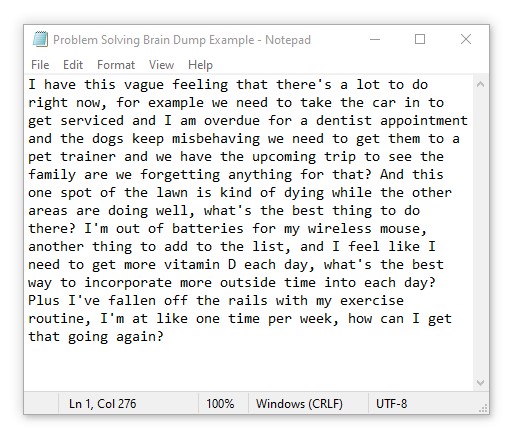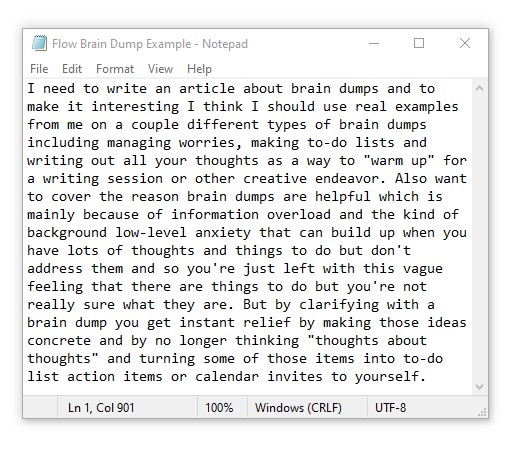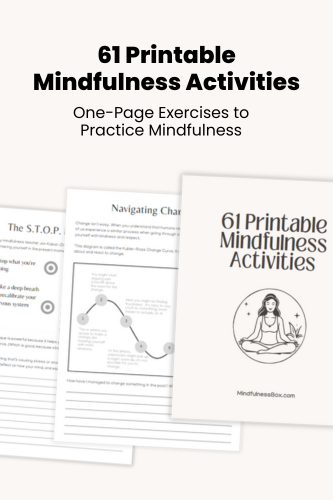Brain dump journals help you transform vague feelings of worry into concrete ideas that you can take action on, or at least understand better. In this article, I’ll give you three behind-the-scenes examples of my own brain dump journaling process so you can decide if this journaling method is for you.
I’ve recently been digging into Sapiens, a book about the history of humanity, and it’s reminded me what a different world we modern humans live in.
There’s an incredible amount to think about these days. Not just basic survival, but navigating a complex world where we have every piece of global information—from trivial to important—at our fingertips.
Get dozens of one-page exercises to help practice mindfulness, meditation, gratitude, and self love. Perfect for printable handouts when teaching mindfulness to groups, students, or in the workplace.
To see examples, plus a full list of the 61 exercises included, click below.
Here’s the scale of what I’m talking about:
500 years ago, the average person didn’t have much exposure to information. Educated people read, but most others didn’t. Throughout their lifetime, the average educated person consumed 74 gigabytes of information through stories and books. (Scientists have actually measured this.)
Today, the average person consumes 74 gigabytes of information DAILY through the Internet, television, smartphones, books, and more.
We’re processing tens of thousands of times more information over the course of our lifetime.
And—short of taking more hikes and turning off our phones—we don’t have many tools to deal with this firehose of information.
That’s where brain dump journaling comes in.
What is a brain dump journal?
A brain dump journal is a way to extract at least some of that 74 gigabytes of daily information from your brain. It doesn’t need to be anything fancy. Brain dump journals are often a simple sheet of paper or even a note file on your computer or phone. Anything that lets you remove information from your head.
Here’s what’s going on when you write in a brain dump journal.
Have you ever talked through your worries with a friend and felt better afterwards—even though nothing was really solved? That’s kind of what the brain dump process does for you.
The mere act of speaking or writing your thoughts down helps turn them from fuzzy notions into concrete ideas.
For all you Harry Potter fans, the Pensieve (aka “memory pool”) is a good visual for what’s happening here.
The problem with letting all that information float around in your head unchecked is that it tends to cluster into circular thinking patterns.
Here’s how that often works for me:
- I have a thought.
- Maybe something that needs to get done, or a worry about the future.
- My mind starts thinking about that thought.
- Soon, my mental landscape is a messy jumble of thoughts and thoughts about thoughts.
This is typical of worry-based thinking. It’s what happens when we let our minds run the show for too long without intervention.
By writing down what’s on your mind, you make it manageable.
How to do brain dump journaling
There are a few types of brain dumps. I’ll separate them into Worry Management, Problem Solving, and Flow. Let’s dig into each.
Worry management brain dump example
Managing worry or anxiety is one of the main values of a brain dump, and it’s also the easiest to execute.
Here’s how it works:
Write out every single thought that’s in your mind. Everything. If you’re writing on paper, you may need a few pages for this. Don’t worry about clarifying your ideas. Just let the words flow as if you were speaking with a friend.
Start listing your worries, and allow them to run their course. I find it easiest to use run-on sentences, Jack Kerouac-style. It should almost sound like your inner child is complaining to your adult self. That’s good. You’re setting yourself up to soothe yourself.
For example:

Writing this out helps crystalize what I’m worrying about (what to focus on with work and how to settle into a new city).
In the course of this rambling, I manage to guilt-trip myself a bit for not doing enough and also offer some possible reframes. Solutions aren’t always possible with worry brain dumps, nor should they necessarily be the goal. The act of writing your thoughts down has its own clarifying benefits.
Now that I’ve externalized the worries, I can step into my adult-self shoes and make a few observations:
- Worries are coming up around finding balance at work and settling into a new city
- I’m guilt-tripping myself a bit (“not sure I’m doing enough”)
- It’s time to go easy on myself and recognize that both work-life balance and feeling at home in a new place are longer pursuits that can’t be solved in a single journaling session
In the course of a full brain dump, you’ll touch on a bunch of random worries. That means it’ll be much longer than this example. If you have the time, write until you no longer have anything to write about.
Problem-solving brain dump example
Brain dumps are also used in a more action-oriented fashion to turn overthinking into a concrete to-do list. When the end of the day leaves you with a nagging, overwhelmed feeling that there’s a lot to do and you’re forgetting things, you could probably use a problem-solving brain dump.
Just as we did with the worry management brain dump, start with all the possible things to do that are on your mind.
For example:

Once you open the floodgates, you’ll be surprised at all the random thoughts that trickle out. These are thoughts that I’ve had at one time or another over the past couple months, and in some cases, I had no idea they were occupying headspace.
Turning them into an actual to-do list can reassure your brain. Here’s how mine shakes out.
- Schedule a time to pack early for the trip to see the family.
- Set up a time to take the car to the dealership
- Make a note to check with the dog daycare facility to see if they offer training.
- Order batteries for the mouse on Amazon.
- Set recurring reminder to water the grass.
- Pick some days/times to commit to exercise over the course of the week.
- Schedule a dentist appointment.
You don’t have to do all of them right away. They can become notes or calendar invites to yourself. Just by making a commitment to your mind that you’re going to do something about each of these items, you may feel a little lighter and less burned by circular thoughts.
Flow brain dump example
Brain dumps are also an incredible creative tool to get into a state of flow. If you’ve ever written your thoughts down in a stream-of-consciousness style, this is more or less what I’m talking about.
This method is perfect for getting started on a creative task, especially writing—articles, emails, speeches, blog posts, short stories, etc.
The advantage is that rather than worry about getting your ideas down coherently, you just deposit them as raw materials and go back in later in “editing mode” to pick out what you actually want to use for your project.
I’ll get a little meta here and share my flow brain dump for this article:

This one is pretty self-explanatory. When you find yourself getting stuck on a project, release all expectations. Just write about anything that comes to mind. Soon, you’ll find yourself producing useful ideas that you can extract and pull into your project.
Brain dump prompts
All of the above examples assume you’re just going to start with a blank page.
But some people would rather journal with prompts. There’s not too much guidance you can give when prompting yourself for a brain dump. But when nothing seems to be flowing, here are a few ideas to elicit thoughts:
- What’s on my mind right now?
- What do I feel like I should be doing but haven’t handled yet?
- What am I worried about right now?
- Is there anything I feel like I’m forgetting?
- What recurring thoughts am I experiencing?
- Am I cycling through any “thoughts about thoughts” at the moment?
- Are there any root causes behind my general feeling of worry?
- What am I “overthinking” about at the moment?
More ways to reduce overwhelm
Brain dump journaling is a great start. Here are some other ways to reduce overwhelm:
- Digital Decluttering (5 Steps to Reduce Digital Overwhelm)
- The STOP Method for Reducing Stress
- How to Train Your Brain to Stop Worrying

My mindfulness practice kicked off in 2016 with a ten-day silent retreat. Since then, I’ve read dozens of books about mindfulness and completed hundreds of hours of meditation. Thinking about what makes humans happy, calm, and peaceful is endlessly fascinating to me.


